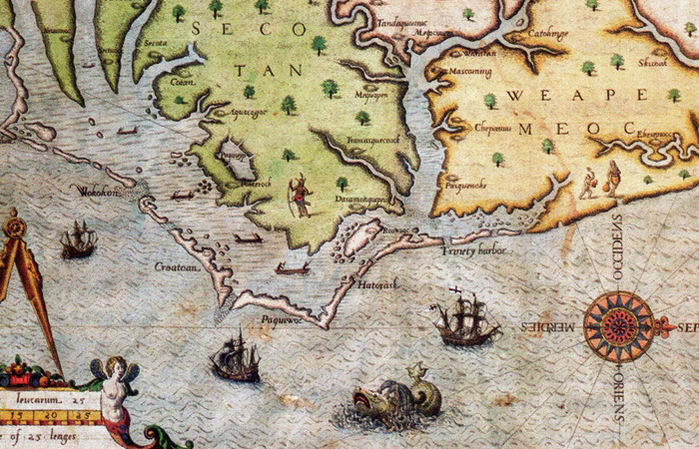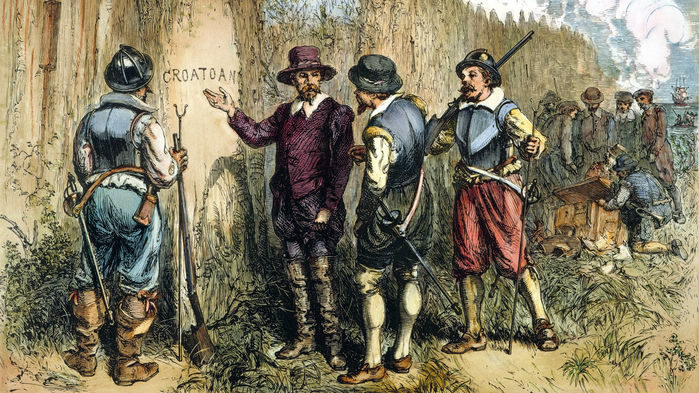
"They were never lost," said Scott Dawson, who has researched records and dug up artifacts where the colonists lived with the Indians in the 16th century. "It was made up. The mystery is over."
Dawson has written a book, published in June, that details his research. It is called The Lost Colony and Hatteras Island, and echos many of the sentiments he has voiced for years.
A team of archaeologists, historians, botanists, geologists and others have conducted digs on small plots in Buxton and Frisco for 11 years.
Dawson and his wife, Maggie, formed the Croatoan Archaeological Society when the digs began. Mark Horton, a professor and archaeologist from England's University of Bristol leads the project. Henry Wright, professor of anthropology at the University of Michigan, is an expert on native history.

The excavated earth looks like layer cake as the centuries pass.
"In a spot the size of two parking spaces, we could find 10,000 pieces," he said.
Pieces found during the project are on display at the Hatteras Library. The rest are in storage.
Dawson's book draws from research into original writings of John White, Thomas Harriot and others. Most of their writings were compiled at the time by English historian Richard Hakluyt.
Records from Jamestown also helped Dawson understand more about the tribes' political structure.
The evidence shows the colony left Roanoke Island with the friendly Croatoans to settle on Hatteras Island. They thrived, ate well, had mixed families and endured for generations. More than a century later, explorer John Lawson found natives with blue eyes who recounted they had ancestors who could "speak out of a book," Lawson wrote.
The two cultures adapted English earrings into fishhooks and gun barrels into sharp-ended tubes to tap tar from trees.
The Lost Colony stemmed from an 1587 expedition. Just weeks after arriving, White had to leave the group of settlers — including his daughter, Eleanor Dare, and newborn granddaughter, Virginia — to get more supplies from England. White was not able to return for three years. When he arrived at Roanoke Island in 1590 he found "CROATOAN" carved on a post and "cro" on a tree. He found no distress marks.

White later wrote of finding the writing on the post, "I greatly joyed that I had found a certain token of their being at Croatoan where Manteo was born ...."
A bad storm and a near mutiny kept White from reaching Hatteras. He returned to England without ever seeing his colony again.
Archaeologists found a flower-shaped clothing clasp belonging to a woman with the other items. Sir Walter Raleigh sent three expeditions to the New World in 1584, 1585 and in 1587. The first two had more military purposes and did not include women. The 1587 group brought 16 women with it, Dawson said.
They also found round post holes where Indians built their long houses 25 feet to 60 feet long and they uncovered square post holes made by English during the same period.
"They were in the Indian village surrounded by long houses," Dawson said.
Bones of turtle, wildfowl and deer bones indicate good eating. Pigs teeth turn up for generations.
"They never had to eat the last pig," Dawson said.
Any skeletons uncovered during the digs were left untouched out of respect, Dawson said.
One artifact could depict a recorded event.
A lead tablet and lead pencil found at the dig could have belonged to White himself, Dawson said. White also was part of the 1585 group, working as an artist who drew natives and wildlife. The British Museum has the originals.
He likely used the newly discovered tablet or a similar one to draw the miniature pictures. The uncovered tablet has an impression of an Englishman shooting a native in the back. The paper drawing has never been found.
Wingina, chief of the Secotans, was shot twice in the back by an Englishman in 1586 at a village near what is now Manns Harbor, Dawson said. The Croatoans assisted the English in the ambush, Dawson said.
The Secotans and the Croatoans hated each other, Dawson said. Secotans enslaved Croatoans just a few years before the English arrived. The English had burned a Secotan village in 1585.
The Croatoans befriended the English as powerful friends with guns and armor. White's colony welcomed their friendship, especially after one of their members, George Howe, was killed by the Secotans.
White was concerned about the danger posed by the Secotans when he left for England. The Croatoans saved the colonists by taking them away from Roanoke Island to their Hatteras Island village, Dawson said.
"You're robbing an entire nation of people of their history by pretending Croatoan is a mystery on a tree," he said. "These were a people that mattered a lot."
Jeff Hampton has written about North Carolina for The Virginian-Pilot since 1997, focusing on the Outer Banks and northeastern North Carolina. jeff.hampton@pilotonline.com



Reader Comments
How does he get his hair to do that?